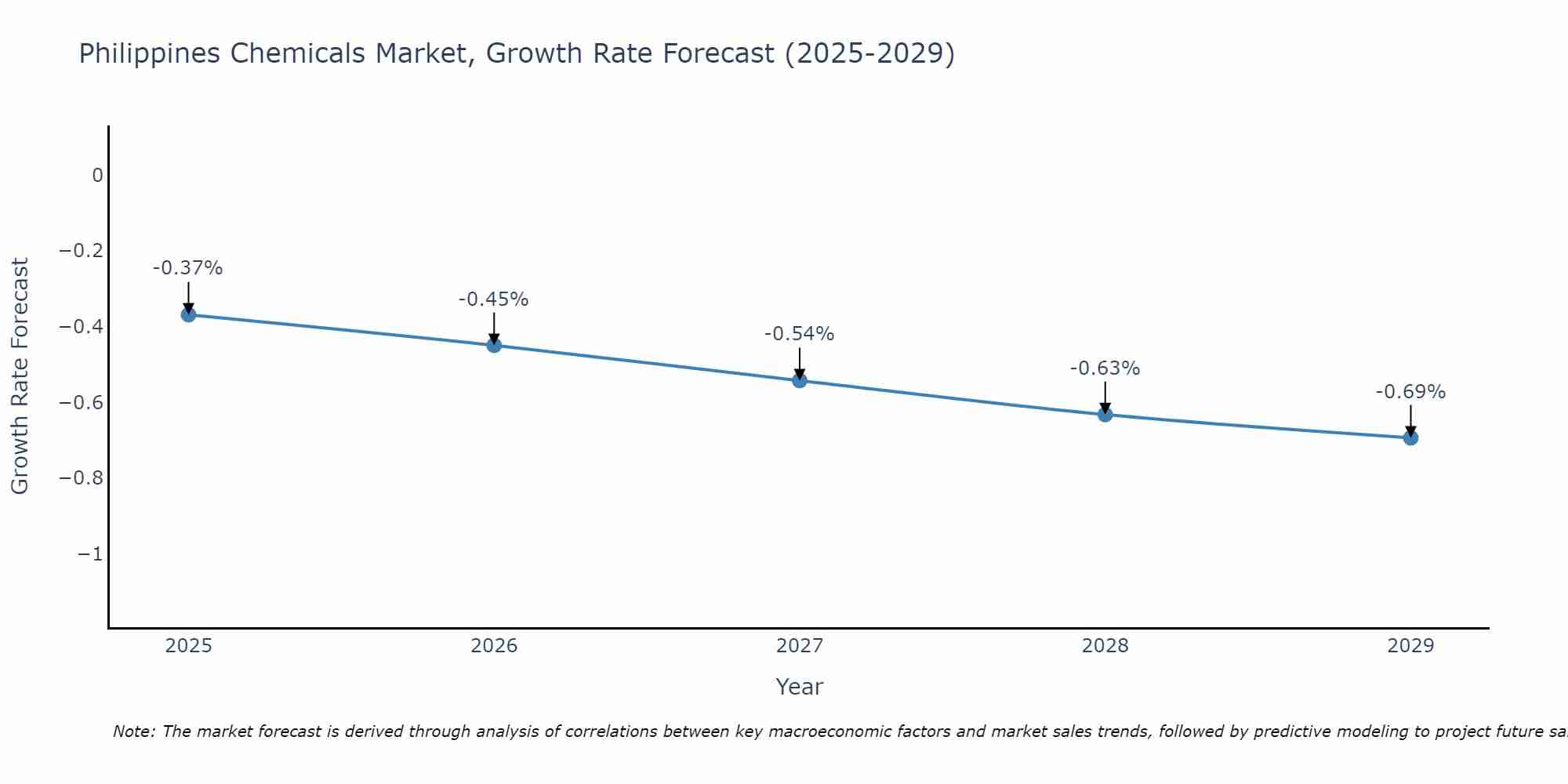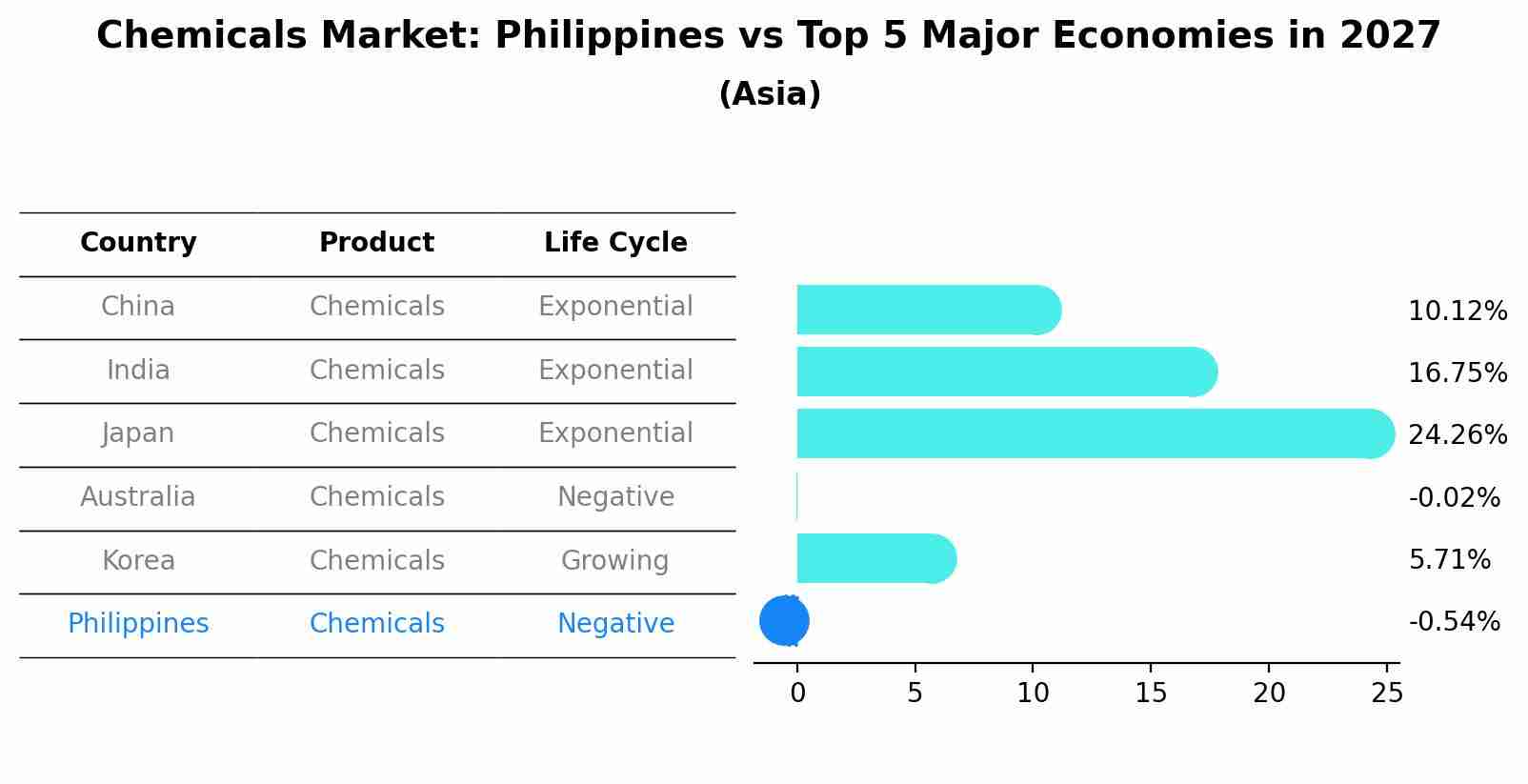Philippines Chemicals Market (2025-2031) Outlook | Value, Analysis, Share, Size, Growth, Forecast, Industry, Trends, Companies & Revenue
| Product Code: ETC251309 | Publication Date: Aug 2022 | Updated Date: Aug 2025 | Product Type: Market Research Report | |
| Publisher: 6Wresearch | Author: Ravi Bhandari | No. of Pages: 75 | No. of Figures: 35 | No. of Tables: 20 |
Philippines Chemicals Market Size Growth Rate
The Philippines Chemicals Market could see a tapering of growth rates over 2025 to 2029. Starting high at -0.37% in 2025, the market steadily declines to -0.69% by 2029.

Chemicals Market: Philippines vs Top 5 Major Economies in 2027 (Asia)
By 2027, Philippines's Chemicals market is forecasted to achieve a negative growth rate of -0.54%, with China leading the Asia region, followed by India, Japan, Australia and South Korea.

philippines cigarette lighters market Synopsis
The Philippines cigarette lighters market has experienced substantial shifts in recent years due to changing consumer preferences and health consciousness. As smoking rates decline and regulations become stricter, the demand for cigarette lighters has been affected. Market data reveals a moderate decline in market size, with a CAGR of approximately -2%, resulting in a market value of around $30 million. This decline is reflective of broader societal trends favoring healthier lifestyles and reduced tobacco consumption. As a result, lighter manufacturers are diversifying their product offerings, catering to outdoor enthusiasts and hobbyists. Looking ahead, adapting to evolving consumer habits and exploring new markets will be essential for the Philippines cigarette lighters market to navigate these challenges and maintain relevance.
Drivers of the Market
The Philippines cigarette lighters market is likely to undergo steady growth in the foreseeable future. While there is a general global trend of declining smoking rates, cigarette lighters still remain in demand due to various factors. Social habits, outdoor activities, and alternative uses (such as lighting candles) contribute to the consistent demand for cigarette lighters. Moreover, the market might witness innovation in terms of designs and safety features to align with changing consumer preferences and regulations.
Challenges of the Market
The Philippines cigarette lighters market encounters notable challenges that influence its future trajectory. Stricter regulations and public health campaigns against smoking have led to a decline in smoking rates, directly impacting the demand for cigarette lighters. The market must navigate changing consumer preferences, with an increasing number of individuals choosing to quit smoking or shift to alternative nicotine products. Economic factors and disposable income levels also influence consumer spending on non-essential items like decorative or novelty lighters, potentially affecting market demand. Furthermore, safety concerns and the potential hazards associated with certain lighter types could lead to increased scrutiny and tighter regulations on their design and manufacturing. Counterfeit and low-quality products flooding the market present additional challenges, as they can compromise consumer trust and safety.
COVID-19 Impact on the Market
The Philippines cigarette lighters market has witnessed shifts due to changing social norms and health consciousness. While cigarette consumption has faced scrutiny, the market for lighters has experienced adjustments. The COVID-19 pandemic introduced additional challenges as hygiene concerns prompted a decline in shared lighter usage. Furthermore, lockdowns and restrictions impacted the market`s retail landscape. As public health awareness continues to grow, cigarette lighter manufacturers are exploring innovations that cater to safety and convenience. Additionally, the market is diversifying into flameless and rechargeable alternatives. While traditional cigarette lighter sales might face headwinds, adapting to emerging consumer preferences and aligning with health trends could determine the market`s future direction.
Key Players in the Market
Despite increasing health awareness, the cigarette lighters market in the Philippines remains relatively stable. Leading players like LighterMasters Inc. and FlameTech Enterprises continue to dominate this market by offering a variety of lighter options, adapting to changing consumer preferences.
Key Highlights of the Report:
- Philippines Chemicals Market Outlook
- Market Size of Philippines Chemicals Market, 2024
- Forecast of Philippines Chemicals Market, 2031
- Historical Data and Forecast of Philippines Chemicals Revenues & Volume for the Period 2021-2031
- Philippines Chemicals Market Trend Evolution
- Philippines Chemicals Market Drivers and Challenges
- Philippines Chemicals Price Trends
- Philippines Chemicals Porter's Five Forces
- Philippines Chemicals Industry Life Cycle
- Historical Data and Forecast of Philippines Chemicals Market Revenues & Volume By Type for the Period 2021-2031
- Historical Data and Forecast of Philippines Chemicals Market Revenues & Volume By Agrochemicals for the Period 2021-2031
- Historical Data and Forecast of Philippines Chemicals Market Revenues & Volume By Dyes and Pigments for the Period 2021-2031
- Historical Data and Forecast of Philippines Chemicals Market Revenues & Volume By Construction Chemicals for the Period 2021-2031
- Historical Data and Forecast of Philippines Chemicals Market Revenues & Volume By Specialty Polymers for the Period 2021-2031
- Historical Data and Forecast of Philippines Chemicals Market Revenues & Volume By Textile Chemicals for the Period 2021-2031
- Historical Data and Forecast of Philippines Chemicals Market Revenues & Volume By Base Ingredients for the Period 2021-2031
- Historical Data and Forecast of Philippines Chemicals Market Revenues & Volume By Surfactants for the Period 2021-2031
- Historical Data and Forecast of Philippines Agrochemicals Chemicals Market Revenues & Volume By Others for the Period 2021-2031
- Philippines Chemicals Import Export Trade Statistics
- Market Opportunity Assessment By Type
- Philippines Chemicals Top Companies Market Share
- Philippines Chemicals Competitive Benchmarking By Technical and Operational Parameters
- Philippines Chemicals Company Profiles
- Philippines Chemicals Key Strategic Recommendations
Frequently Asked Questions About the Market Study (FAQs):
1 Executive Summary |
2 Introduction |
2.1 Key Highlights of the Report |
2.2 Report Description |
2.3 Market Scope & Segmentation |
2.4 Research Methodology |
2.5 Assumptions |
3 Philippines Chemicals Market Overview |
3.1 Philippines Country Macro Economic Indicators |
3.2 Philippines Chemicals Market Revenues & Volume, 2021 & 2031F |
3.3 Philippines Chemicals Market - Industry Life Cycle |
3.4 Philippines Chemicals Market - Porter's Five Forces |
3.5 Philippines Chemicals Market Revenues & Volume Share, By Type, 2021 & 2031F |
4 Philippines Chemicals Market Dynamics |
4.1 Impact Analysis |
4.2 Market Drivers |
4.2.1 Growing demand for chemicals in various industries such as agriculture, construction, and manufacturing. |
4.2.2 Increasing government investments in infrastructure projects driving the demand for chemicals. |
4.2.3 Rising population and urbanization leading to higher consumption of chemical products. |
4.3 Market Restraints |
4.3.1 Fluctuating prices of raw materials impacting the profitability of chemical manufacturers. |
4.3.2 Stringent government regulations on the use and disposal of chemicals affecting market operations. |
4.3.3 Competition from imported chemicals impacting the market share of local manufacturers. |
5 Philippines Chemicals Market Trends |
6 Philippines Chemicals Market, By Types |
6.1 Philippines Chemicals Market, By Type |
6.1.1 Overview and Analysis |
6.1.2 Philippines Chemicals Market Revenues & Volume, By Type, 2021-2031F |
6.1.3 Philippines Chemicals Market Revenues & Volume, By Agrochemicals, 2021-2031F |
6.1.4 Philippines Chemicals Market Revenues & Volume, By Dyes and Pigments, 2021-2031F |
6.1.5 Philippines Chemicals Market Revenues & Volume, By Construction Chemicals, 2021-2031F |
6.1.6 Philippines Chemicals Market Revenues & Volume, By Specialty Polymers, 2021-2031F |
6.1.7 Philippines Chemicals Market Revenues & Volume, By Textile Chemicals, 2021-2031F |
6.1.8 Philippines Chemicals Market Revenues & Volume, By Base Ingredients, 2021-2031F |
6.1.9 Philippines Chemicals Market Revenues & Volume, By Others, 2021-2031F |
6.1.10 Philippines Chemicals Market Revenues & Volume, By Others, 2021-2031F |
7 Philippines Chemicals Market Import-Export Trade Statistics |
7.1 Philippines Chemicals Market Export to Major Countries |
7.2 Philippines Chemicals Market Imports from Major Countries |
8 Philippines Chemicals Market Key Performance Indicators |
8.1 Research and development (RD) investment in innovative chemical products. |
8.2 Environmental sustainability initiatives such as reduction in greenhouse gas emissions and waste management practices. |
8.3 Adoption rate of advanced technologies in chemical manufacturing processes. |
8.4 Percentage of revenue from new product launches. |
8.5 Number of strategic partnerships and collaborations for market expansion. |
9 Philippines Chemicals Market - Opportunity Assessment |
9.1 Philippines Chemicals Market Opportunity Assessment, By Type, 2021 & 2031F |
10 Philippines Chemicals Market - Competitive Landscape |
10.1 Philippines Chemicals Market Revenue Share, By Companies, 2024 |
10.2 Philippines Chemicals Market Competitive Benchmarking, By Operating and Technical Parameters |
11 Company Profiles |
12 Recommendations |
13 Disclaimer |
- Single User License$ 1,995
- Department License$ 2,400
- Site License$ 3,120
- Global License$ 3,795
Search
Thought Leadership and Analyst Meet
Our Clients
Related Reports
- Germany Breakfast Food Market (2026-2032) | Industry, Share, Growth, Size, Companies, Value, Analysis, Revenue, Trends, Forecast & Outlook
- Australia Briquette Market (2025-2031) | Growth, Size, Revenue, Forecast, Analysis, Trends, Value, Share, Industry & Companies
- Vietnam System Integrator Market (2025-2031) | Size, Companies, Analysis, Industry, Value, Forecast, Growth, Trends, Revenue & Share
- ASEAN and Thailand Brain Health Supplements Market (2025-2031) | Strategy, Consumer Insights, Analysis, Investment Trends, Opportunities, Growth, Size, Share, Industry, Revenue, Segments, Value, Segmentation, Supply, Forecast, Restraints, Outlook, Competition, Drivers, Trends, Demand, Pricing Analysis, Competitive, Strategic Insights, Companies, Challenges
- ASEAN Bearings Market (2025-2031) | Strategy, Consumer Insights, Analysis, Investment Trends, Opportunities, Growth, Size, Share, Industry, Revenue, Segments, Value, Segmentation, Supply, Forecast, Restraints, Outlook, Competition, Drivers, Trends, Demand, Pricing Analysis, Competitive, Strategic Insights, Companies, Challenges
- Europe Flooring Market (2025-2031) | Outlook, Share, Industry, Trends, Forecast, Companies, Revenue, Size, Analysis, Growth & Value
- Saudi Arabia Manlift Market (2025-2031) | Outlook, Size, Growth, Trends, Companies, Industry, Revenue, Value, Share, Forecast & Analysis
- Uganda Excavator, Crane, and Wheel Loaders Market (2025-2031) | Strategy, Consumer Insights, Analysis, Investment Trends, Opportunities, Growth, Size, Share, Industry, Revenue, Segments, Value, Segmentation, Supply, Forecast, Restraints, Outlook, Competition, Drivers, Trends, Demand, Pricing Analysis, Competitive, Strategic Insights, Companies, Challenges
- Rwanda Excavator, Crane, and Wheel Loaders Market (2025-2031) | Strategy, Consumer Insights, Analysis, Investment Trends, Opportunities, Growth, Size, Share, Industry, Revenue, Segments, Value, Segmentation, Supply, Forecast, Restraints, Outlook, Competition, Drivers, Trends, Demand, Pricing Analysis, Competitive, Strategic Insights, Companies, Challenges
- Kenya Excavator, Crane, and Wheel Loaders Market (2025-2031) | Strategy, Consumer Insights, Analysis, Investment Trends, Opportunities, Growth, Size, Share, Industry, Revenue, Segments, Value, Segmentation, Supply, Forecast, Restraints, Outlook, Competition, Drivers, Trends, Demand, Pricing Analysis, Competitive, Strategic Insights, Companies, Challenges
Industry Events and Analyst Meet
Whitepaper
- Middle East & Africa Commercial Security Market Click here to view more.
- Middle East & Africa Fire Safety Systems & Equipment Market Click here to view more.
- GCC Drone Market Click here to view more.
- Middle East Lighting Fixture Market Click here to view more.
- GCC Physical & Perimeter Security Market Click here to view more.
6WResearch In News
- Doha a strategic location for EV manufacturing hub: IPA Qatar
- Demand for luxury TVs surging in the GCC, says Samsung
- Empowering Growth: The Thriving Journey of Bangladesh’s Cable Industry
- Demand for luxury TVs surging in the GCC, says Samsung
- Video call with a traditional healer? Once unthinkable, it’s now common in South Africa
- Intelligent Buildings To Smooth GCC’s Path To Net Zero


















